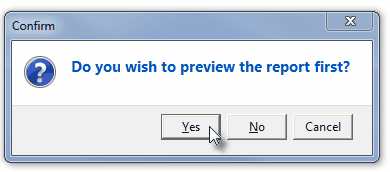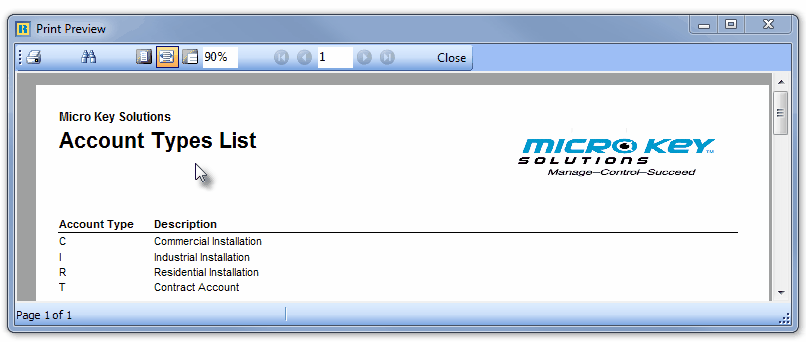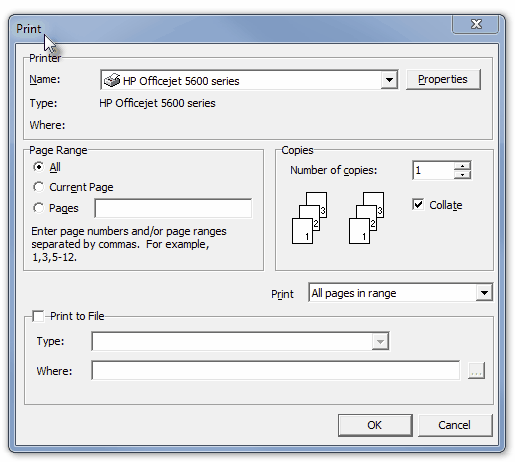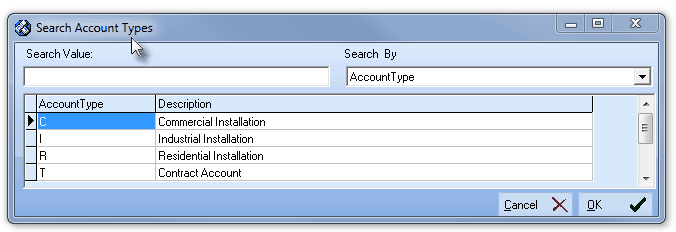| • | As part of that process, each monitored Subscriber must be assigned an Account Type - which is a general classification of the type of monitored account this will be. |
| • | Examples of an Account Type are Commercial, Industrial, Residential, UL, or Institutional. |
| • | You may define as many Account Types as appropriate for your business model. |
| • | The Account Type classification allows Operators to better understand the type of system to which (s)he is currently responding. |
| • | To enter Account Types, on the Main Menu Select Maintenance and Choose Central Station, then Click Account Types. |

Account Types Form
| • | This Account Types Form may be Re-sized by Dragging the Top and/or Bottom up or down, and/or the Right side in or out. |
| • | Navigation Menu - The Navigation Menu is located at the top of the Account Types Form. |

| • | This Navigation Menu provides the normal Record Movement, New, Edit, Delete, Cancel, Save, and Refresh options; as well as special Print and Search functions. |
| • | Record Editing section - The details of the currently selected record are displayed below the Navigation Menu at the center (Main Body) of the Account Types Form. |
| • | Table View tab - A tabular (spreadsheet style) Table View of the currently defined Account Types is accessible by Clicking the Table View tab at the bottom of the Account Types Form. |

| • | To display a specific Account Type record in the Record Editing section, Click on that record within the Table View section, or use the Search Icon (see the "Using the Special Functions" section later in this chapter). |
| • | This Table View information may be Pinned in Place by Clicking the Pin Icon on the right. |

Account Types Form - with Table View tab Pinned Open
| ▪ | You may Un-Pin this Table View by Clicking the Pin Icon again. |
| ▪ | Click on any listed record to display that information in the center (Main Body) of the Form. |
| • | There are two columns of data in this Account Types Record Listing: |
| 1) | Account Code - The Code which identifies this Account Type. |
| 2) | Description - The description for this Account Type. |
| • | Each column's Header Name describes the data contained in that column. |
| ▪ | Clicking on a Header Name will set the order in which the Account Types will be listed. |
| ▪ | Clicking on the same Header Name will set the order in the opposite direction (ascending vs. descending). |

| ▪ | The Header Name that is determining the Order of the list will have an Icon indicating the Order displayed next to that Header Name. |
| • | To define the Account Types which will be used to identify the type of monitored account in the Central Station Data Form. |
| • | Click the  Icon to start the Account Type entry in the Record Editing section. Icon to start the Account Type entry in the Record Editing section. |
| • | Account Code - Enter up to three characters - Capital letters, spaces, numbers and basic punctuation marks are accepted - to identify this Account Type. |
| • | Description - Enter a brief description of up to 30 characters in length for this Account Type which is a general classification of the type of monitored account it is. |
| ▪ | The Description may up to 30 characters in length and include upper and/or lower case letters, numbers, spaces and normally used punctuation marks. |
| • | Click the  Icon to record this entry. Icon to record this entry. |
| • | Repeat this process, as needed, to define each of the Account Types which provide contract monitoring and other recurring services for your Company. |
| □ | Using the Special Functions on the Navigation Menu at the top of the Account Type Form: |
| • | Print - Click the Print Icon to View and/or Print a list of the Account Types. |

| • | Yes - Click the Yes button to View a copy of the report. |

| • | No - Click the No button to open the Windows® Print dialog where a copy of the report may be sent to a selected Printer, or Printed to a File. |

| • | Cancel - Click the Cancel button to close this Print question and return to the Form. |
| • | Search - Click the Search Icon to open the Search Account Types dialog. |

Search dialog
| • | See the "Using the Generic Search dialog" section in the Advanced Search Dialog chapter for more information about this Search dialog. |










![]()

![]()



